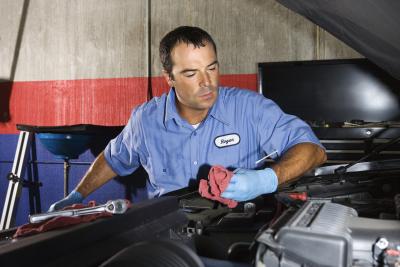
Unlike their modern counterparts, which feature overhead camshafts, classic Mustangs rely on valve lifters and pushrods to actuate the rocker arms within the cylinder heads. As the camshaft twists, its lobes cause the lifters to rise and fall. The lifters then tilt the rocker arms back and forth with the pushrods. Fortunately, replacing valve lifters on a Mustang is fairly straightforward.
Remove the bolts which surround the lip of the valve covers with a wrench then pull the valve covers off of the cylinder heads.
Remove the bolts which secure the intake manifold to the top of the engine with a wrench then lift the intake manifold off of the engine.
Remove the pushrods from the lifters. The pushrods connect the rocker arms to the valve lifters and must be removed before the lifters can be withdrawn from the engine block. A single nut is located in the center of each rocker arm. Loosen the nut with a wrench until the rocker arm can be rotated off of the tip of the pushrod then pull the pushrod out of the engine. If the pushrods will be reused, keep each pushrod in order as the some pushrod must be used with the same rocker arm. Also note which end of the pushrod rests against the rocker arm so that the pushrods are not installed upside down.
Remove the valve lifters with a lifter removal tool. The tool is essentially a long rod with a magnetic tip. Insert the magnetic tip into the indentation inside the top of the lifter then pull the lifter out of the engine block.
Coat the bottom of each new valve lifter with engine assembly lubrication then slide each lifter into the bores within the engine block.
Lower the pushrods through the cylinder heads until the bottom of each pushrod rests against the top of its respective lifter. Remember to install each pushrod in the same location it was removed from. Rotate the tip of each rocker arm onto the tip of its pushrod. Tighten each rocker arm’s retaining nut with a wrench just enough to retain the pushrod against the bottom of the rocker arm.
Install the intake manifold with new intake manifold gaskets. Tighten each intake manifold bolt to between 20 and 22 foot-pounds of torque with a torque wrench.
Remove the spark plug from the front of the cylinder head on the driver’s side of the engine with a wrench. Cover the spark plug hole with a thumb then rotate the crankshaft with a socket wrench in a clockwise direction. The crankshaft can be rotated by turning the bolt in the center of the harmonic balancer pulley. Rotate the crankshaft until pressure is felt coming out of the spark plug hole. The pressure indicates that the piston is rising on the compression stroke. Continue to rotate the crankshaft until the timing pointer on the passenger’s side of the timing chain cover aligns with the “TDC” mark on the side of the harmonic balancer.
Adjust the valves for the cylinder from which the spark plug was removed with a feeler gauge. Each cylinder is controlled by two rocker arms located on top of the cylinder head. Adjustment begins by measuring the distance between the tip of the rocker arm and the top of its pushrod. This distance is typically referred to as “valve clearance.” A feeler gauge features a number of different blades, each of varying thickness used to measure this distance. The proper distance varies with the particular engine design so consult the engine’s specification’s manual for the proper valve clearance. Insert the blade of the feeler gauge, which represents the proper thickness, between the tip of the rocker arm and the top of its pushrod. Tighten or loosen the adjusting nut in the center of the rocker arm until the proper distance is achieved for both rocker arms. Install the spark plug, then repeat Steps 8 and 9 for the remaining cylinders.
Install the valve covers to the cylinder heads with new valve cover gaskets.